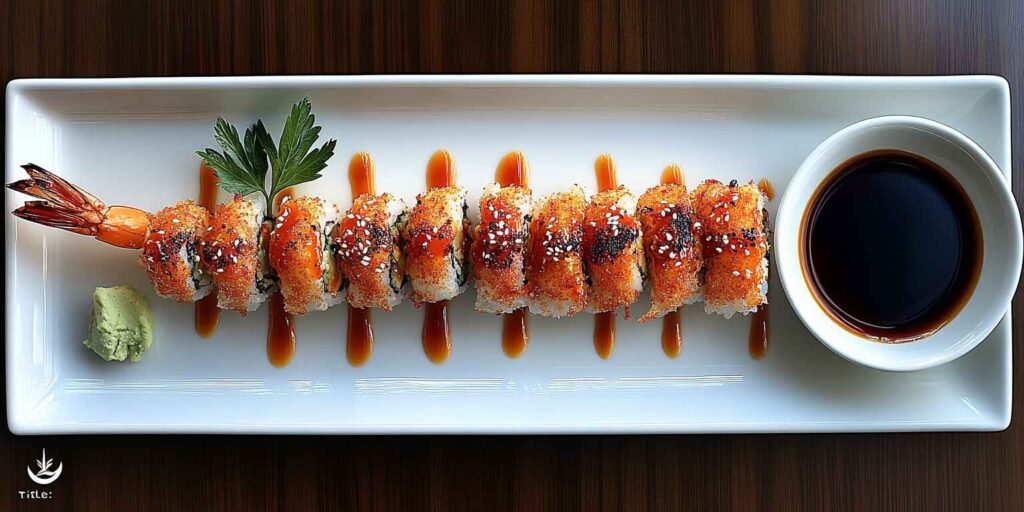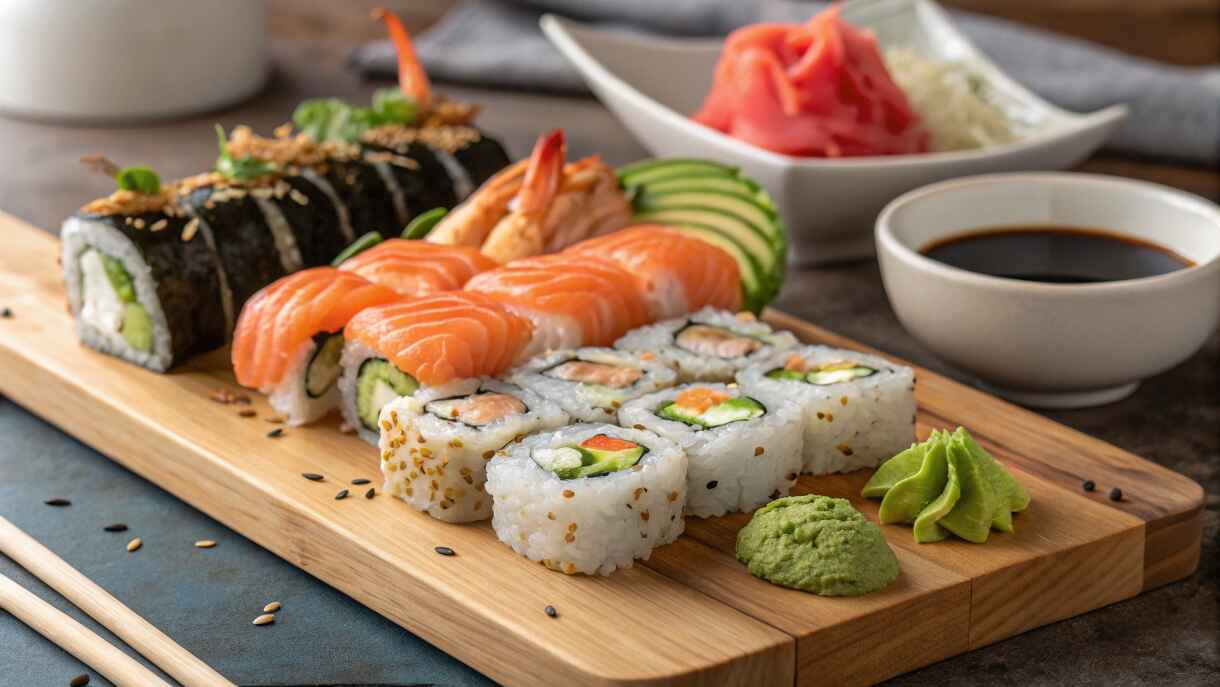When it comes to sushi, one question that often pops up is: “Is maki raw?” If you’re a sushi lover—or even a sushi newbie—you’ve probably wondered about this. Maki, a type of sushi roll, is known for its distinctive seaweed-wrapped appearance. But is it always raw? Let’s dive into the world of maki sushi and uncover the truth!
What is Maki?
Maki (巻き), which literally means “roll” in Japanese, is a beloved sushi dish where rice and fillings are wrapped in a sheet of seaweed (nori). Think of it as a tiny flavor-packed burrito but with an elegant Japanese twist. 🍣 Whether you’re biting into a classic tuna roll or a creative fusion roll, maki is an adventure for your taste buds.
The Origins and History of Maki Sushi
Did you know maki sushi dates back centuries? It originated in Japan as a convenient way to enjoy fresh fish and rice. The art of rolling sushi took off during the Edo period (1603-1868), making it portable and easy to eat. Over time, this humble roll evolved into a culinary masterpiece enjoyed worldwide.
The Popularity of Maki Around the World
Fast forward to today, maki is a global superstar. From traditional Japanese restaurants to supermarket shelves, you’ll find maki rolls everywhere. And thanks to its versatility, there’s a maki roll for everyone—raw, cooked, vegan, you name it! 🌎
Ingredients of Maki: Raw or Cooked?
So, let’s get to the big question: is maki always raw? The answer is… it depends. Maki can feature raw fish, but there are also plenty of cooked and vegetarian options. Let’s break it down.
Common Ingredients in Maki Rolls
Here’s what usually goes into a maki roll:
- Sushi rice – Sticky rice seasoned with vinegar.
- Nori – A sheet of seaweed that holds everything together.
- Fillings – This can be raw fish, cooked seafood, veggies, or even fruits.
Sometimes, sauces or toppings like sesame seeds or roe are added for extra flair.
Raw Fish in Maki: A Tradition or a Preference?
Raw fish, like tuna or salmon, is a traditional filling in maki. It’s fresh, flavorful, and gives that authentic sushi experience. However, it’s not a must. Many people prefer cooked ingredients or plant-based options, and that’s perfectly fine!
Cooked and Vegetarian Maki Options
If raw fish isn’t your thing, don’t worry. Cooked maki rolls, like shrimp tempura or eel, are just as delicious. Plus, vegetarian rolls with avocado, cucumber, or sweet potato offer a refreshing, crunchy twist. 🥑

Types of Maki and Their Ingredients
Now that we know maki can be raw or cooked, let’s explore the different types and their unique ingredients.
Traditional Maki Rolls with Raw Fish
These rolls stick to the basics:
- Tuna Roll: Fresh, raw tuna paired with rice and nori.
- Salmon Roll: Raw salmon for a buttery, melt-in-your-mouth texture.
“Freshness is key when enjoying raw fish in maki. Always go for sushi-grade fish from trusted sources!”
Cooked Variants: Shrimp Tempura, Eel, and More
If you’re in the mood for something cooked, try these:
- Shrimp Tempura Roll: Crispy fried shrimp with a drizzle of spicy mayo.
- Unagi Roll: Grilled eel with a sweet, savory glaze.
Vegetarian and Vegan-Friendly Maki Rolls
Looking for plant-based options? You’ll love these:
- Avocado Roll: Creamy avocado wrapped in sushi rice and nori.
- Cucumber Roll: Simple yet refreshing, perfect for beginners.
- Sweet Potato Roll: Roasted or fried sweet potato for a unique twist.
See? Maki isn’t just about raw fish. It’s all about creativity and personal preference. 🎉
Common Misconceptions About Maki
Maki might seem straightforward, but there are a few myths that need busting.
Is All Sushi Raw? Debunking the Myth
Let’s clear this up once and for all: not all sushi is raw. While many sushi dishes feature raw fish, cooked options and vegetarian rolls are equally common. So, if raw fish isn’t your jam, you’ve still got plenty of options to enjoy sushi.
Maki vs. Other Sushi Types: Understanding the Difference
Maki is just one type of sushi. Other types include:
- Nigiri: A slice of fish atop a small bed of rice.
- Sashimi: Thinly sliced raw fish served without rice.
- Uramaki: Inside-out rolls with rice on the outside.
Each has its own charm, but maki stands out for its versatile, roll-style presentation.
Nutrition Facts of Maki Sushi
Wondering about the calories? Here’s a quick guide to help:
| Maki Type | Calories (per roll) | Protein (g) | Fat (g) |
|---|---|---|---|
| Salmon Roll | 230 | 13 | 5 |
| Avocado Roll | 140 | 2 | 7 |
| Shrimp Tempura Roll | 320 | 9 | 15 |
Keep in mind, the toppings and sauces can add extra calories, so it’s always good to enjoy them in moderation. 🥢
Health and Safety Concerns with Raw Maki
Eating raw fish can be a little intimidating, especially if you’re new to sushi. Let’s tackle the health and safety concerns so you can enjoy your maki rolls with peace of mind.
Is It Safe to Eat Raw Maki? Key Considerations
The short answer is yes—if it’s prepared properly. Sushi chefs use fish that is specifically labeled as “sushi-grade,” meaning it’s been carefully handled to reduce the risk of contamination. This ensures you get fresh, high-quality ingredients that are safe to eat.
Risks of Consuming Raw Fish: What You Need to Know
Of course, there are some risks to eating raw fish. These include:
- Parasites: Though rare, raw fish can harbor parasites like tapeworms. Freezing fish at ultra-low temperatures kills these.
- Bacteria: Improperly stored fish can carry bacteria such as salmonella or listeria.
The good news? Trusted sushi restaurants follow strict guidelines to ensure their fish is safe. So as long as you choose wisely, you’re in good hands. 🐟
Tips for Choosing High-Quality Maki Sushi
Want to enjoy raw maki without worry? Here are some tips:
- Stick to reputable restaurants: Look for places with good reviews and a clean environment.
- Ask questions: Don’t hesitate to ask the chef about the source and quality of the fish.
- Trust your senses: Fresh fish should smell clean, not fishy.
Following these steps will help you savor the deliciousness of raw maki safely.

How to Make Maki at Home: Cooked and Raw Variations
Craving maki but don’t want to head out? No problem! Making maki at home is easier than you think. Here’s how you can do it step by step.
Tools and Ingredients You’ll Need
First, gather your tools:
- Sushi mat (bamboo mat)
- Sharp knife
- Rice paddle or spoon
Next, grab these ingredients:
| Ingredient | Quantity |
|---|---|
| Sushi rice | 2 cups, cooked |
| Nori sheets | 4-6 sheets |
| Fillings (raw fish, cooked shrimp, avocado, cucumber) | As needed |
| Soy sauce and wasabi | For dipping |
Step-by-Step Guide to Making Maki Rolls
- Prepare the rice: Cook sushi rice, then mix it with sushi vinegar for that tangy flavor.
- Lay the nori: Place a sheet of nori shiny side down on your bamboo mat.
- Add rice: Spread a thin layer of rice over the nori, leaving a small edge at the top.
- Layer your fillings: Add your choice of raw fish, cooked shrimp, avocado, cucumber, or any combination.
- Roll it up: Use the mat to roll the nori tightly, tucking as you go.
- Slice and serve: Cut the roll into bite-sized pieces with a sharp knife dipped in water.
And there you have it—homemade maki that’s as good as the restaurant version! 🍣
Creative Maki Variations to Try
Once you’ve mastered the basics, why not get creative? Try these fun variations:
- Spicy Tuna Roll: Add a dollop of spicy mayo to your tuna filling.
- Rainbow Roll: Top your roll with a variety of fish for a colorful twist.
- Fruit Maki: Use mango, strawberry, or even pineapple for a sweet treat.
The possibilities are endless, so let your imagination run wild!
Solving Common Problems with Maki
Even with the best intentions, things can go wrong when making or eating maki. Don’t worry—we’ve got solutions to common problems.
Raw Fish Not Fresh? How to Identify Quality Ingredients
Fresh fish is the heart of a great maki roll. If the fish looks dull, smells overly fishy, or feels slimy, it’s a no-go. Always choose sushi-grade fish from a trusted source.
Struggling to Roll Maki Properly? Tips for Perfect Rolls
Rolling maki can feel like an art, but here’s a trick: don’t overfill your roll. Less is more! Also, use firm but gentle pressure when rolling with your bamboo mat.
Making Maki Suitable for Dietary Restrictions
Need gluten-free or vegan options? Swap soy sauce for tamari and use veggies or tofu as fillings. Sushi is super adaptable, so you can easily customize it to your needs. 🌱
Last Bite
So, is maki raw? It can be, but it doesn’t have to be. From traditional raw fish rolls to cooked and vegetarian variations, maki is a versatile dish that offers something for everyone. Whether you’re enjoying it at a sushi bar or making it at home, the key is to embrace the adventure and savor every bite. Happy sushi-ing! 🎉 For more about Maki .

